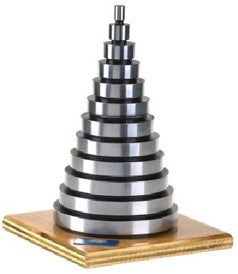
Micrometer Masters
Model 16 1/2E (English) & Model 16 1/2M (Metric)
Model 16 1E (English) & Model 16 1M (Metric)
- 1/2”-6.00” diameter in 1/2” increments
- 12.5-150mm diameter in 12.5mm increments
- Case hardened, stabilized, ground and lapped to ±.0001” or ±.0025mm
Model 16 1E (English) & Model 16 1M (Metric)
- 1.00”-6.00” diameter in 1.00” increments
- 25-150mm diameter in 25.0mm increments
- Case hardened, stabilized, ground and lapped to ±.0001” or ±.0025mm
| PART # | DESCRIPTION | PRICE | SALE PRICE |
| 112E | Micrometer Set Masters Model 112E (English) | $2,175.00 | |
| 112M | Micrometer Set Masters Model 112M (Metric) | $2,175.00 | |
| MM161M | Micrometer masters Model 16-1M (Metric) | $1,173.00 | |
| MM161E | Micrometer masters Model 16-1E (English) | $1,173.00 | |
| MM16M | Micrometer masters Model 16 1/2E (Metric) | $1,575.00 | |
| MM16E | Micrometer masters Model 16 1/2E (English) | $1,600.00 |
Micrometer masters are used to calibrate and set micrometers
The master is superior to gage block calibration because they do not require block stacks and therefore it is much faster to inspect the linear range of the tool. In addition they indicate wear on the micrometer anvil because it replicates how the micrometer is used.
Micrometers like any other piece of measuring equipment need to be calibrated on a regular cycle. This can be accomplished with the use of gage blocks but unfortunately this practice can be hard on the gage block surface. It will also negatively affect the wringing ability prematurely and requires significant operator skills to become proficient. Gage blocks can also produce errors in calibrating micrometers due to a flat surface versus a diameter. This is typically what is being measured.
Micrometer masters are extremely useful being fixed in place and simulating the parts being checked. Model 1E and 1M for one-inch micrometers, for example, has two (2) odd steps, one at .512 and the other at .762. These steps allow you to check the micrometer at 90 and 180 degrees from the fixed anvil respectfully thereby checking the parallelism of the anvils.
The master is superior to gage block calibration because they do not require block stacks and therefore it is much faster to inspect the linear range of the tool. In addition they indicate wear on the micrometer anvil because it replicates how the micrometer is used.
Micrometers like any other piece of measuring equipment need to be calibrated on a regular cycle. This can be accomplished with the use of gage blocks but unfortunately this practice can be hard on the gage block surface. It will also negatively affect the wringing ability prematurely and requires significant operator skills to become proficient. Gage blocks can also produce errors in calibrating micrometers due to a flat surface versus a diameter. This is typically what is being measured.
Micrometer masters are extremely useful being fixed in place and simulating the parts being checked. Model 1E and 1M for one-inch micrometers, for example, has two (2) odd steps, one at .512 and the other at .762. These steps allow you to check the micrometer at 90 and 180 degrees from the fixed anvil respectfully thereby checking the parallelism of the anvils.


